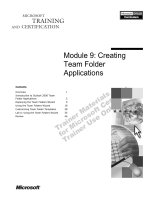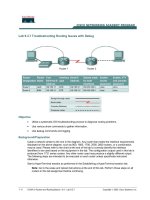Tài liệu Lesson 9: Polymorphism ppt
Bạn đang xem bản rút gọn của tài liệu. Xem và tải ngay bản đầy đủ của tài liệu tại đây (41.71 KB, 4 trang )
Using Excellent Tools to Write Web Applications Targeting
the .NET Common Language Runtime (CLR)
[Home] [Up] [Lesson01] [Lesson02] [Lesson03] [Lesson04] [Lesson05
[Lesson06] [Lesson07] [Lesson08] [Lesson09] [Lesson10] [Lesson11
[Lesson12] [Lesson13]
On sale Now! C#
Unleashed is an in-
depth guide for
intermediate to
advanced software
developers to learn
the C#
programming
language and
serve as a desktop
reference.
.
.
.
.
.
.
.
.
.
.
The C# Station Tutorial
by Joe Mayo, 01/15/01
Lesson 9: Polymorphism
This lesson teaches about Polymorphism in C#. Our objectives are as
follows:
l
Learn What Polymorphism Is.
l
Implement a Virtual Method.
l
Override a Virtual Method.
l
Use Polymorphism in a Program.
Another primary concept of object-oriented programming is
Polymorphism. It allows you to implement derived class methods through
a base class pointer during run-time. This is handy when you need to
assign a group of objects to an array and then invoke each of their
methods. They won't necessarily have to be the same object type.
However, if they're related by inheritance, you can add them to the array
as the inherited type. Then if they all share the same method name, that
method of each object can be invoked. This lesson will show you how to
accomplish this.
Listing 9-1. A Base Class With a Virtual Method: DrawingObject.cs
using System;
public class DrawingObject
{
public virtual void Draw()
{
Console.WriteLine("I'm just a generic drawing object.");
}
}
Listing 9-1 shows the DrawingObject class. This will be the base class for
other objects to inherit from. It has a single method named Draw(). The
Draw() method has a virtual modifier. The virtual modifier indicate to
Page 1 of 4Tutorial
6/24/2002 />derived classes that they can override this method. The Draw() method of
the DrawingObject class performs a single action of printing the
statement, "I'm just a generic drawing object.", to the console.
Listing 9-2. Derived Classes With Override Methods: Line.cs, Circle.cs, and
Square.cs
using System;
public class Line : DrawingObject
{
public override void Draw()
{
Console.WriteLine("I'm a Line.");
}
}
public class Circle : DrawingObject
{
public override void Draw()
{
Console.WriteLine("I'm a Circle.");
}
}
public class Square : DrawingObject
{
public override void Draw()
{
Console.WriteLine("I'm a Square.");
}
}
Listing 9-2 shows three classes. These classes inherit the DrawingObject
class. Each class has a Draw() method and each Draw() method has an
override modifier. The override modifier allows a method to override the
virtual method of it's base class at run-time. The override will happen
only if the class is referenced through a base class reference. Overriding
methods must have the same signature, name and parameters, as the
virtual base class method it is overriding.
Listing 9-3. Program Implementing Polymorphism: DrawDemo.cs
using System;
public class DrawDemo
{
public static int Main(string[] args)
{
DrawingObject[] dObj = new DrawingObject[4];
dObj[0] = new Line();
dObj[1] = new Circle();
dObj[2] = new Square();
dObj[3] = new DrawingObject();
Page 2 of 4Tutorial
6/24/2002 />
foreach (DrawingObject drawObj in dObj)
{
drawObj.Draw();
}
return 0;
}
}
Listing 9-3 shows a program that uses the classes defined in Listing 9-1 and
Listing 9-2. This program implements polymorphism. In the Main()
method of the DrawDemo class, there is an array being created. The type
of object in this array is the DrawingObject class. The array is named
dObj and is being initialized to hold four objects of type DrawingObject.
Next the dObj array is initialized. Because of their inheritance
relationship with the DrawingObject class, the Line, Circle, and Square
classes can be assigned to the dObj array. Without this capability, you
would have to create an array for each type. Inheritance allows derived
objects to act like their base class, which saves work.
After the array is initialized, there is a foreach loop that looks at each
element of the array. Within the foreach loop the Draw() method is
invoked on each element of the dObj array. Because of polymorphism,
the run-time type of each object is invoked. The type of the reference
object from the dObj array is a DrawingObject. However, that doesn't
matter because the derived classes override the virtual Draw() method of
the DrawingObject class. This makes the overriden Draw() methods of the
derived classes execute when the Draw() method is called using the
DrawingObject base class reference from the dObj array. Here's what the
output looks like:
Output:
I'm a Line.
I'm a Circle.
I'm a Square.
I'm just a generic drawing object.
The override Draw() method of each derived class executes as shown in
the DrawDemo program. The last line is from the virtual Draw() method of
the DrawingObject class. This is because the actual run-time type of the
fourth array element was a DrawingObject object.
The code in this lesson can be compiled with the following command line:
csc DrawDemo.cs DrawingObject.cs Circle.cs Line.cs Square.cs
It will create the file DrawDemo.exe, which defaulted to the name of the
Page 3 of 4Tutorial
6/24/2002 />first file on the command line.
In summary, you should now have a basic understanding of polymorphism.
You know how to define a virtual method. You can implement a derived
class method that overrides a virtual method. This relationship between
virtual methods and the derived class methods that override them enables
polymorphism. This lesson showed how to use this relationship between
classes to implement polymorphism in a program.
I invite you to return for Lesson 10: Properties.
Your feedback is very important and I appreciate any constructive
contributions you have. Please feel free to contact me for any questions or
comments you may have about this lesson.
Feedback
C# Station
Copyright (c) 2002 C# Station
Page 4 of 4Tutorial
6/24/2002 />









